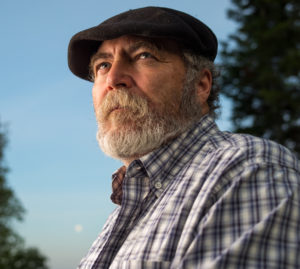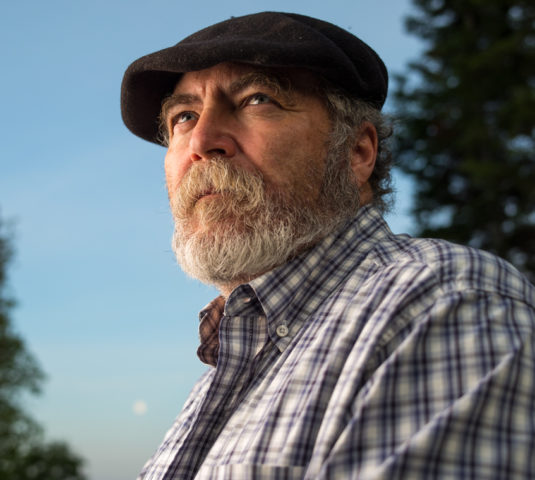Filmmaker Charles Thériault’s passion is observing. His troubling encounter with a young man in the northern rural New Brunswick community of Kedgwick made him turn his camera on the forest. The result: a popular web series documenting decades of forest mismanagement and what he calls “corporate capture” of our forest.
Thériault’s impression that all was fine in New Brunswick’s woods was shattered when he met a 26-year-old man who had tried to commit suicide. The man was $1 million in debt, a debt he had accrued from working as a contractor, cutting wood for J.D. Irving, the largest forestry player in the province. According to Thériault, the contractors are in a perpetual debt cycle of taking out loans to buy new machines.

Thériault spoke with several contractors who had their loans for new machines co-signed by J.D. Irving. These types of systems, in which workers have their financial affairs tied to the company they work for, are ripe for exploitation. “It’s a system of slavery-like control over the workers,” claims Thériault.
About 100 students, professors and others concerned about the state of New Brunswick’s forest filled a room at St. Thomas University (STU) in Fredericton on Oct. 16 to hear Thériault share his story.
STU professor Joan McFarland invited Thériault to speak to her New Brunswick Economy class and the public. “We are using, as class materials, the fascinating 28 videos on his blog, isourforestreallyours.ca. The videos expose the disastrous situation of the Crown forest in New Brunswick. We felt that he would have something important to say. We weren’t disappointed,” says McFarland.
New Brunswick’s land base, which has never been ceded by the Wolastoqiyik, Mi’kmaq and Passamoquoddy peoples, is carved out as 50 per cent public land (also known as Crown land), 30 per cent private land and 20 per cent freehold. The New Brunswick government is tasked with managing the public forest in a way that benefits all New Brunswickers but many like Thériault argue that private interests are largely benefiting from forestry practices today.
Forestry has been a main source of jobs and way of life in many rural communities across New Brunswick for generations. The closure of many mills across the province in the early 2000s devastated many forestry-dependent communities. However, as mills closed and people were thrown out of work, wood continued to be cut from New Brunswick’s public forest in record volumes. The Conservation Council of New Brunswick reported that timber harvested from public land reached a record high of 5.4 million cubic metres from 2006 to 2007.
Intensive industrial practices, such as clearcutting and conversion of natural forests into plantations, have also not sat well with people from across the province. In 2015, the Auditor-General of New Brunswick recommended reducing clearcutting on Crown forest. A 2008 survey of public attitudes on Crown forestry management by Nadeau and Beckley noted that participants–from both rural and urban areas of New Brunswick–wanted water protection and biodiversity protection to be the top two forest management priorities. Participants chose jobs as the third priority.
“New Brunswickers do not trust the forest industry to manage Crown Lands.” Episode 5 of Is Our Forest Really Ours. Produced by Charles Thériault.
Thériault, who has travelled the world, producing media for the National Film Board and the Discovery Channel, says that his time spent working inside government when Frank McKenna was the Premier of New Brunswick opened his eyes to “how important decisions were being made in the backroom.” He remarks, “this was not my kind of politics so I left politics for filmmaking.”
Thériault was raised in what he describes as an “Acadian ghetto in Moncton,” Georgetown. He recalls the paved roads and services ending just outside Anglophone Moncton. He eventually settled in the rural northern New Brunswick community of Kedgwick with his wife, Betty St. Pierre, who he says, “taught him how to stand up.” In 2009, St. Pierre organized a petition to stop spraying the forest after she said she and other forestry workers were sprayed.
In a story reported by the NB Media Co-op in 2009, St. Pierre said, “A man reported fish kills along a stream here after the last spraying. It is not normal to do that to the forest. We can’t prove we are sick because of the spraying but cancer and pesticides have been linked. People are starting to question why do so many people in our community, in Northern New Brunswick, have cancer and rare cancers.”
“Where were the journalists?” questions Thériault. “I approached several reporters in the province about these stories of forest mismanagement. I was told that I was too controversial. I spoke the truth. They were too afraid,” says Thériault.
“I knew I had to report on what was happening in our woods because the press was not doing it,” says Thériault. He set out to do what he calls a “social awareness raising experiment.” Supported by the New Brunswick Federation of Woodlot Owners, the filmmaker produced a number of online videos with people who had critical things to say about forestry practices in New Brunswick. The popular videos can be watched online at isourforestreallyours.ca.
Outdated forestry legislation that benefits large industrial interests is a main culprit behind forest mismanagement in the province, according to forestry experts, conservation groups and woodlot owners as reported in the Conservation Council’s 2017 Forest Report Card. However, getting the story of forest mismanagement told has been difficult in a province where J.D. Irving, Ltd. owns a large portion of the media.
The popularity of Thériault’s short videos and NB Media Co-op’s stories on spraying the forest reveal that people are hungry to hear the forest story in New Brunswick from the point of view of the small woodlot owners, forestry workers, scientists and conservationists. “After my first few videos, I started getting contacted by retired Deputy Ministers of Natural Resources who were now free to talk,” notes Thériault.
Don McCrea explains how the 1982 N.B. Crown Land and Forest Act came into being and why he refused to accept the post of Deputy Minister of Natural Resources. Episode 11 of Is Our Forest Really Ours. Produced by Charles Thériault.
Besides J.D. Irving, “other private interests are making tremendous amounts of money from our forest while we, the public, feel the pain,” says Thériault. The Auditor-General’s 2015 report affirms Thériault’s claim: Kim MacPherson’s audit of the Department of Natural Resources finances, from 2009 to 2014, revealed that the province had lost between $7 to 10 million each year on our public forests.
In perhaps his most popular video, Thériault tells the story of how forestry management was redesigned in ways that benefited companies that are associated with Bud Bird and Frank McKenna.
In Episode 9 of Is Our Forest Really Ours, Charles Thériault discusses the involvement of Frank McKenna and Bud Bird in forest management in New Brunswick. Produced by Charles Thériault.
According to Thériault, Bud Bird, a well-known businessman and former Progressive Conservative politician, while Minister of Natural Resources under the Hatfield government, “essentially privatized the Crown forest by dividing the land into ten timber licenses in 1982.”
In response to concerns of woodlot owners, the Crown Lands and Forest Act was amended in 1982 to say that the industry’s primary source of wood fibre had to come from private woodlots. The big players in the forestry industry objected to the new power given to woodlot owners and their marketing boards but Bird was able to console the industry by consolidating 483 parcels of Crown land into ten licenses. Today, only four companies, all large, multinational corporations, control Crown forest. J.D. Irving is the largest Crown forest licensee. Theriault argues, “This system has impoverished New Brunswick.”
Frank McKenna, while Premier of New Brunswick, changed the Act by striking the woodlot owners’ guarantee of primary source of wood supply to the province’s mills. Woodlot owners have been fighting ever since 1992 to have the market advantage returned to them. They say they are not able to compete with cheap Crown wood and they point to the overcutting of the public forest as one symptom of a broken forest management regime.
McKenna and Bird entered again in Thériault’s storytelling of New Brunswick’s forest history. In 2009, Fraser Papers, that owned the mill in Edmundston, filed for bankruptcy protection with the Canadian and American governments so that it could restructure. At the time, Brookfield Asset Management was the majority shareholder of Fraser Papers. McKenna is a long-time board member of Brookfield, a company that denied 450 retired mill workers in Edmundston their full pensions.
The restructuring of Fraser Papers involved splitting the company into two new companies: Acadian Timber and Twin Rivers. Bird is a former board director of Acadian Timber. According to Acadian Timber’s website, today, the company is the “second largest timberland operator in New Brunswick and Maine.” Twin Rivers operates the Edmundston mill and is one of the companies that the Alward government signed a controversial and unprecedented contract with in 2014 that allowed the company to cut an increased amount of wood from their Crown land license every year.
Frustrated by a political system that is captured by corporations, Thériault ran in the last two provincial elections, first as an independent and more recently, in the September 2018 election, as a Green Party candidate for Restigouche West. In that election, he came in second, with 31.5 per cent of the vote.
What is Thériault’s vision for rural New Brunswick? He says that decentralization is needed to restore community involvement. Decentralization involves local decision-making bodies having more power and responsibilities over resources such as the forest as well as health care and other public services. He says rural New Brunswick also needs to grapple with climate change and that resilient forests and food security should be at the top of our collective agendas.
This article and video was made possible with support from RAVEN – Rural Action & Voices for the Environment. It originally appeared in the NB Media Co-Op on Nov.5, 2018.
Tracy Glynn is working with RAVEN as a doctoral researcher and was the Conservation Council of New Brunswick’s forest campaigner from 2006 to 2018.

